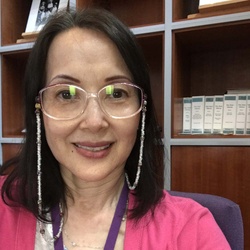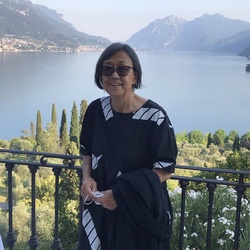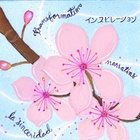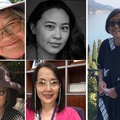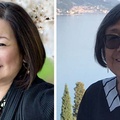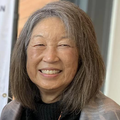When first asked to curate the Nikkei Uncovered poetry column in 2016, the very first person I wanted to feature was the great Amy Uyematsu. Alongside the countless many, I am yet another poet/writer who holds so much sorrow with the loss of Amy after her long and fierce battle with cancer. She survived through many years, showing up year after year with her poetry and gracing the "classroom" even in retirement, to lead a special group of writers in Little Tokyo. Beginning in 2015 at the Far East Lounge on First Street, Amy met with writers 1-2 times a month, and they continued together virtually through the pandemic all the way through last year. The final four writers who kept the group going were Kathy Masaoka, Keiko Miya, Nina Chan, and Miya Iwataki. We are so grateful they agreed to let us share just a few pieces from their many years of writing in Amy's group, WOWW - Women Word Warriors. We are splitting this feature over two days.
In Part 1, we are featuring Kathy Masaoka and Keiko Miya. In Part 2, we are featuring Miya Iwataki and Nina Chan. We will continue these tributes to Amy throughout the year, with "response" poems next month - I asked Sansei/Yonsei and younger generation poets to join me as we share some poetry after our wonderful inspiration, Amy Uyematsu.
Please submit an "after Amy" poem if you are so moved and we'll try to feature you at some point.
— traci kato-kiriyama
* * * * *
Keiko Ikari Miya’s upbringing both in Kesennuma, Japan and in the US (New York City and Southern California) has made her keenly aware of the differences in societies. She was able to enjoy being a classroom teacher at an elementary school in Maywood, CA for 11 years, then at Roosevelt High School, Boyle Heights as a teacher of Japanese for 17 years. The 23 years in NYC and 35 plus years in SoCal have afforded Keiko experiences working with people of many races and ethnicities, and she finds joy in working with people emphatically. Keiko has been enjoying volunteering at the Japanese American National Museum (JANM) since 2017, especially helping the offspring of Issei and Nisei families research their ancestors’ roots, mainly in the U.S. The Hirasaki National Resource Center of the Museum offers this opportunity for research.
Hokusai’s Wave
Multitudes of clutching claws
Classically have evoked frightful power
With graceful curves cradling boats and fishermen in tact
Dares to dwarf Mt. Fuji, tallest point in the Land of the Rising Sun
A favorite woodblock of so many, as was mine
Until the tsunami of northeast Japan on March 11, 2011
Devouring tens of thousands of people
Devastating domiciles and businesses of many times more
Including my families’
I can no longer regard Hokusai’s Wave with reverence and fondness
Only with fright and dread
Yet Hokusai so captured the power!
I had bought tenugui towels with the “Wave” for student motivation
Some students enthralled by the art
Toiled hard to earn the towels
The “Wave” speaks a universal language, undyingly.
A cousin who also lost his mother in the tsunami of 2011, helping to look for more lost family members everyday for many weeks
This year sent me again a new year’s card
of “The Wave”
How could he look at that card with adoration? I say to myself
How can he forgive what had taken
away so many people so dear?
I appreciate the art but cannot bear to display it, as it reminds us
Nature can be all too powerful.
Then an aha moment came:
My cousin really holds the sea in reverence
Being a chief officer of a merchant ship on which he has been for many years
He lives in the wave and is in tune with it, it is part of his livelihood and his soul.
Already in his 70s, he seems unable to part from it; it has him in its powerful “claws”.
Is love in the air?
Wished it were so, continuously
Less suffering in our depraved societies
Sometimes in the air when you seek it
Invisibly pervasive when you enjoy contacting a friend or two or three
Be they of your gender or no
Love for one’s parents can be different from love for siblings
And for each again variable
May not be automatic
Physical love can be separated from
Soulmate love
Love for own children may not even be unconditional
Separation from which types of love above would cause most heart break?
Mourn not too long, lest your health and psyche suffer
The same proponent also warns
“Do not be heartbroken forever”
But that maybe easier said than done.
Worries about the future (senryu form)
Will people accept
Diversity of others, gleaning
Diversity of selves?
Plastics from take outs
During pandemic are rife
But aid livelihoods
Education here
Falls far behind other states
If not countries, now
Good reports (in tanka form)
Family friend’s son
In 1950’s
Had polio scare
A hospital’s costs for kids there
Paid for by Burt Lancaster
My niece Maya
Sole family survivor
Of Japan’s earthquake
Now 22, helps bring life
As an obstetrics nurse
Ian Manuel
Teenager spent 18 years
In solitary
Of life sentence for shooting
Pardoned by victim, Ian now poet
*These poems are copyrighted by Keiko Ikari Miya (2023).
* * * * *
Kathy Nishimoto Masaoka was born and raised in multicultural Boyle Heights. The Vietnam War and Asian American Studies at University of California, Berkeley in the late ’60s were important influences on her values. Since the 1970s, she has worked on youth, workers, and housing issues in Little Tokyo, and Japanese American redress. Currently Co-chair of the Nikkei for Civil Rights & Redress (NCRR), she served on the Editorial Team for the book, NCRR: The Grassroots Struggle for Japanese American Redress and Reparations, helped to educate about the camps through the film/curriculum, Stand Up for Justice, and worked on the NCRR 9/11 Committee to help build relationships with the American Muslim community through programs like Break the Fast and Bridging Communities.
She represented NCRR to support the rights of Korean and other minorities in Japan and is involved with Nikkei Progressives, Vigilant Love, and the Sustainable Little Tokyo project, and working on issues such as reparations for Comfort Women and Black folks, the rights of immigrants, and Little Tokyo’s future.
Death in a moment
Death taking many long years
Death suddenly
Death in a week of good byes
Making acceptance easier
I have witnessed death in a few different ways.
The first was my mother’s in 1981.
Everyone around us seemed to know that
our mom was dying except for my sister and me.
We were angry when the doctor scolded us for
calling him when she couldn’t eat, saying
“Don’t you know she is not going to get better?”
People came to visit as if it were the last time
which confused and disturbed us.
We were the last to understand.
When she went into a coma, we should have let her go,
but, instead, we called the ambulance and she was then put on tubes.
I remember her shaking her head as if to say, “no more.”
My dad’s death was unexpected – at least for us.
He seemed to know and had been preparing for it.
He would talk to me about the kind of service he wanted,
his request that we find a restaurant nearby,
so people would not have to travel far.
Again, my sister and I were not ready for it.
He went into emergency with a bad flu and
the hospital assured us he would be out in the evening.
Instead, he developed pneumonia and stayed that night,
aware enough to say, “thank you for coming.”
Little did we know that he would be in ICU the next day
and that we be have to decide whether to resuscitate him.
He had not signed any papers about his wishes, so we went with ours – save him.
They told us it was painful and that he would keep coding.
We let him go – the hardest decision we had to make.
My sister beat death once when her cancer went into remission.
We never talked about a funeral or what she wanted.
How could we? She wanted to focus on fighting.
But we knew she was going and had hospice support.
I wanted to be with her in her last moments.
Death came in a week for Sachi, my huband Mark’s mother,
giving enough time for the grandkids to come
and for the last three Kawahara siblings to be together.
She had been ready for many years but waited,
so that her family could say their good byes.
What does it mean to be safe?
Fly under the radar.
Don’t stick out or stand out
Keep quiet – stay in the background
Go with the flow
Assimilate
Be the best but act humble
Never show off or brag
Act demur and innocent
Laugh at yourself to put people at ease
Do not challenge
Never make others feel uncomfortable
Avoid embarrassing others, especially in public
Express disagreements in a gentle and indirect manner
Don’t speak up for others or you might be the target
Don’t speak up for others and you will be the target
Whose standards are we trying to live up to?
Who are we trying to please?
What are we trying to fit into? A society based on greed.
White countries stealing land from the Indigenous and
Building wealth from the labor of Black bodies?
Jim Matsuoka warned the CWRIC that we, minorities,
Would become a cancer in this country but I disagree.
Racism is the cancer eating away at this country
And we are the cure.
Response to “What Does It Mean to Be Safe”
Fly high - above the radar to be seen
Stick out and stand out
Be loud – go to the front of the line
Go against the tide
Resist
Be proud of being your best self
Talk about what you do
Assert and acknowledge yourself
Don’t be concerned about how your ideas land
Challenge
Make others uncomfortable – it is needed
Don’t try to please others – what for?
Don’t try to fit in – to what?
Don’t accommodate, don’t be an accomplice to
White Supremacy
*These poems are copyrighted by Kathy Nishimoto Masaoka (2023).
© 2023 Keiko Ikari Miya; Kathy Nishimoto Masaoka




